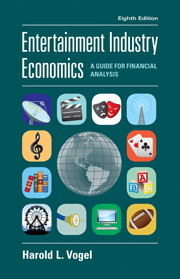Book contents
- Frontmatter
- Contents
- Preface
- Entertainment Industry Economics
- PART I Introduction
- PART II Media-dependent entertainment
- PART III Live entertainment
- Chapter 11 Gaming and wagering
- Chapter 12 Sports
- Chapter 13 Performing arts and culture
- Chapter 14 Amusement/theme parks
- PART IV Roundup
- Appendix A Sources of information
- Appendix B Major games of chance
- Appendix C Supplementary data
- Glossary
- References
- Index
- References
Chapter 13 - Performing arts and culture
from PART III - Live entertainment
Published online by Cambridge University Press: 01 June 2011
- Frontmatter
- Contents
- Preface
- Entertainment Industry Economics
- PART I Introduction
- PART II Media-dependent entertainment
- PART III Live entertainment
- Chapter 11 Gaming and wagering
- Chapter 12 Sports
- Chapter 13 Performing arts and culture
- Chapter 14 Amusement/theme parks
- PART IV Roundup
- Appendix A Sources of information
- Appendix B Major games of chance
- Appendix C Supplementary data
- Glossary
- References
- Index
- References
Summary
Break a leg!
It has been said of all the arts generally that they are a product of disciplined virtuosity in which you are the resource that perceives the value. As such, then, the performing arts in particular generate more psychic than pecuniary income, and they operate under somewhat different economic assumptions than the other entertainment industries thus far discussed. In fact, many organizations in this segment are nonprofit, requiring for their very existence substantial subsidy from government and private-foundation grants and from contributions by individuals
Although the fundamental creative processes in the performing arts have remained essentially unchanged for centuries, technological developments have been important in mitigating the pernicious effects of inexorably rising costs. Fortunately, it still doesn't cost anything to wish performers well by telling them to “break a leg.”
Audiences and offerings
The potential widespread appeal of live performances notwithstanding, there are severe time and financial constraints that limit audience size and scope. This was already apparent even as far back as the eighteenth century, when a theater ticket cost more than a full day's wage. As Baumol and Bowen (1968) indicated in their seminal study, the audience for high culture is dominated by highly educated individuals in high income brackets, an observation supported by the more recent data presented in Figure 13.1.
Although education appears to have a somewhat stronger effect than income, another hypothesis as to why the audience for live performances seems to become ever more exclusive was offered by Linder (1970), who noted that as economic growth increases our incomes and the available array of consumption goods, there is a tendency toward more “goods intensity” at the expense of time spent on cultural activities.
- Type
- Chapter
- Information
- Entertainment Industry EconomicsA Guide for Financial Analysis, pp. 479 - 507Publisher: Cambridge University PressPrint publication year: 2010



